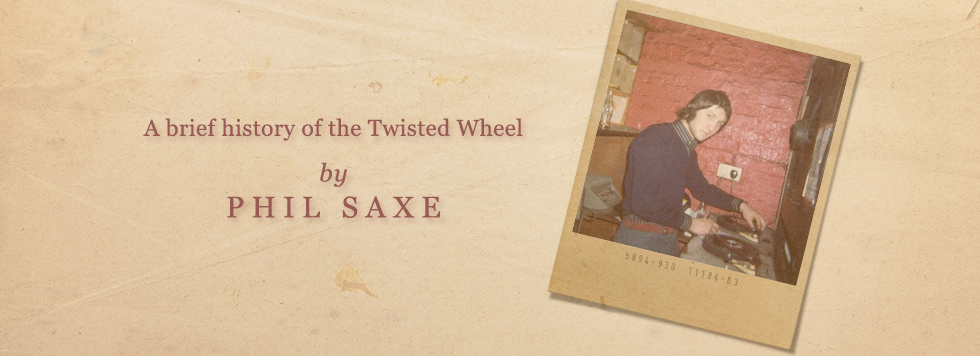A Brief History of the Twisted Wheel: By Phil Saxe

Phil Saxe was a frequent Twisted Wheel attendee over a five year period from ’66 till its closure in ’71 (from the age of 15 till 19) and was one of the DJs for the last 18 months. In some circles, Brian Phillips (who also DJ’d at the Wheel around that time) and Phil are perceived as the founding figures of Northern Soul. Phil went on to DJ at Placemate, run Somewear in Manchester (the birthpace of the late ’80’s Manchester flares scene), discover and manage Happy Mondays, become head of A&R at Factory Records and the In The City music convention, and now lectures in management at the Liverpool Institute for Performing Arts.
The Twisted Wheel 1963-1971
Why is it legendary whereas the Jigsaw, Oasis, Jungfrau, Staxx, Blue Note and Top Twenty are all but forgotten?
A relatively short life spread over two locations, on the opposite sides of Manchester’s city centre – Brazenose Street, just off Deansgate, and Whitworth Street in the shadow of Piccadilly station.
Humble beginnings from Left Wing Coffee Bar to infamous ‘den of inequity’, witnessing the ebb and flow of various scenes and a myriad of musical policies.
From ‘dossers’ sporting bell bottoms, duffel coats and a penchant for folk and blues, through ‘mods’ adorned in their green, blue and red mid-length leather coats, dressed to the nines whilst adopting the cool of soul, to the frenetic, amphetamine-fuelled sweat drenched precursors to the Northern Soulies of the seventies.
A proud catalogue of featured artists playing to enthusiastic, knowledgable audiences encompassing beat, blues and soul including luminaries such a Sonny Boy Williamson, John Lee Hooker, Memphis Slim, Spencer Davies Group, Ike and Tina Turner, Ben E King, Billy Stewart, the Drifters, Junior Walker and Edwin Starr.
Weeknights, Tuesdays and Fridays. Early and all-night sessions on Saturdays.
Club nights, after its demise, springing up to commemorate and celebrate a mythical period in Manchester’s cultural heritage.
I first heard of the Wheel in ‘65 when I was 13. I hung around All Saints youth club on Barton Road, Stretford. Some older lads were trying to impress us young ‘uns. They talked about attending allnighters at this club in town.
At 14, I hung out with some slightly older local lads, and others from North Manchester. We frequented young mod haunts such as Oasis and Jungfrau, in the city centre, the Swinging Door in West Disdbury and Whisky A-Go-Go in Salford.
In late ’66 I visited the Wheel for the first time. The Whitworth Street one. I never attended the original on Brazenose Street. Not an allnighter, of course. Initially, it was the early Saturday sessions finishing at eleven, half hour before the Wheel reopened its doors for the allnighter, and the relatively tame weeknights but it wasn’t long before all-nighters, and all they entailed, took over my life.
The first record that grabbed my attention was Elmore James’s ‘Dust my blues’ on Sue. James’s distinctive electric twang blew me away. But it wasn’t long before I was hankering after Tony Clarke’s ‘Ain’t Love Good, Ain’t Love Proud’ and the soul bug truly got me. For the next five years, with very few exceptions, I was in the Wheel each and every Saturday night and Sunday morning.
By 1968, the Wheel was losing its edge. New clubs such as Top Twenty in Hollinwood were beginning to play better stuff. New laws on ‘internal possession’ led to the crowd changing. The Wheel had to differentiate itself from the drinking-based ‘night clubs’ such as Top of the Town, Sounds and Disco Takis. It did by hiring new, younger DJs who introduced faster, rarer, imported sounds that lesser clubs could not get hold of. The crowd became younger, they travelled from farther afield to attend and they became more distinctive in dress, language and mannerisms. The dancing became more athletic with circles gathering around dancers who leapt, flipped and spun to the incessant beats and rhythms.
Sometime in 1970, Dave Godin, Blues and Soul journalist and London’s Soul City shop owner, visited the club and dubbed the music he heard Northern Soul. The term didn’t catch on immediately but reached its peak in the mid-seventies elsewhere. By then the Wheel was no more. It had metamorphosed into an 8pm – 2.am nightclub where alcohol not amphetamines drove the dance floor and disco dominated the decks.
What did we wear? Of course, clothing styles altered regularly over the five years I was a regular but there were staples that were as cool in ’71 as they were in’66. Boys: Lightweight, mohair 18 inch bottom parallel trousers with turn-ups short enough to show brightly coloured socks above antique-look brogues. Fred Perrys under three-buttoned, single-breasted jackets featuring 15inch centre-vents. Steel combs in your top pocket. Sideburns and cropped hair. Plaid holdall style bags. Girls: Crimplene pastel shaded mini-dresses, short Twiggy hairstyles, pink nails and lips, white tights. All quintessentially Twisted Wheel.








